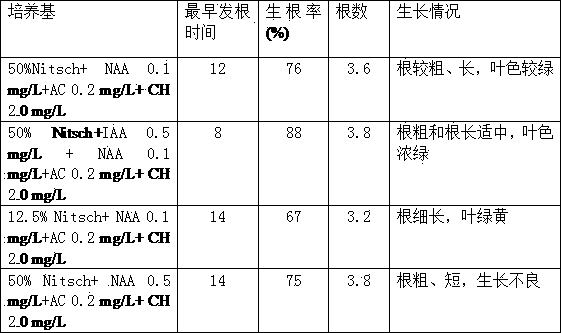Method applied to tissue culture and rapid propagation of chimonanthus nitens
A technology for tissue culture and wintersweet, applied in horticultural methods, botany equipment and methods, horticulture, etc., can solve the problems of easy browning, difficult rooting, vitrification and other problems of wintersweet tissue culture, and achieve low browning rate, High survival rate and fast rooting effect
- Summary
- Abstract
- Description
- Claims
- Application Information
AI Technical Summary
Problems solved by technology
Method used
Image
Examples
Embodiment 1
[0021] A method for tissue culture and rapid propagation of Myrtle japonicus, comprising the following steps in turn:
[0022] (1) Obtaining sterile vaccines:
[0023] Take the mature waxberry fruit, peel off the oblong achene, cut off a little at each end of the achene with surgical scissors, be careful not to cut the seed coat or damage the seed, and carefully peel off the achene with the complete seed coat with your fingernails. Seeds, soaked in 0.2% HgCl in a clean bench 2 Disinfect in the solution for 17-40 minutes (too short time is easy to contaminate, too long time is easy to cause seed death), take it out, soak in sterile water and rinse 3 times, each time for 5 minutes, inoculate in Nitsch+GA 3 0.1 mg / L +6-BA 2.0 mg / L+NAA 0.2mg / L (“+” means mixed). The added amount of sucrose in this medium was 30 g / L, the added amount of agar was 7 g / L, and the pH was 5.8-6.0. The medium was sterilized at 121°C for 20 minutes by high temperature and high pressure, and cultured in...
Embodiment 2
[0044] Effects of Different Medium Additives on Callus Induction and Adventitious Bud Induction
[0045] The difference between this example and example 1 lies in step (2): cut off the cotyledons and divide them into 1 cm sections with a scalpel. 2 Small pieces of about the size are inoculated in the medium of Nitsch+TDZ 0.1-2.0 mg / L+NAA 0-2.0 mg / L+PVP 0-5.0 mg / L+LH 0-1.0 mg / L, cultured in light culture Indoors, the culture temperature was (25±1)°C, and after every 14 hours of light culture, it was transferred to the dark for 10 hours, and the light intensity was 30-40 μmol / (m 2 s). The cotyledons began to expand at 8-15 days, yellow-green dense callus began to appear at 11-25 days, and adventitious buds differentiated from the callus at 28-40 days, the callus induction rate was 70-100%, and the differentiation rate was 28 -70%, some explants browned after the callus was produced, and the browning rate was 5-45%. Nitsch+TDZ 0.5 mg / L+NAA 0.2 mg / L+PVP 1.0 mg / L+LH 0.5 mg / L was...
Embodiment 3
[0050] Effects of Different Proliferation Medium Additives on Proliferation of Adventitious Buds and Strong Seedlings
[0051] The difference between this example and Example 1 lies in step (3): Cut the differentiated shoots from the callus and transfer to the proliferation medium Nitsch+TDZ 0-2.0 mg / L+6-BA 0-5.0 mg / L+CH 0-5.0 mg / L+PVP 1.0 mg / L for proliferation culture, the multiplication factor can reach 3.5-7.2 in 25 days. Among them, Nitsch+TDZ 0.3 mg / L +6-BA 1.0 mg / L+CH 2.0 mg / L+PVP 1.0 mg / L had the best effect, the multiplication factor was 7.0, no vitrification occurred, and the buds grew normally and the leaf color normal. Although the addition of CH did not significantly increase the proliferation rate, it slightly promoted the proliferation rate, and also promoted the adventitious buds' strong seedlings. Generally speaking, the reason for vitrification is that the concentration of the hormone used is too high. As long as the hormone is adjusted at an appropr...
PUM
 Login to View More
Login to View More Abstract
Description
Claims
Application Information
 Login to View More
Login to View More - R&D
- Intellectual Property
- Life Sciences
- Materials
- Tech Scout
- Unparalleled Data Quality
- Higher Quality Content
- 60% Fewer Hallucinations
Browse by: Latest US Patents, China's latest patents, Technical Efficacy Thesaurus, Application Domain, Technology Topic, Popular Technical Reports.
© 2025 PatSnap. All rights reserved.Legal|Privacy policy|Modern Slavery Act Transparency Statement|Sitemap|About US| Contact US: help@patsnap.com



